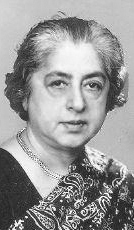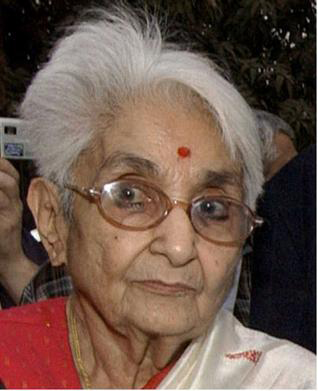|
In 1961, I accompanied Sarah Paul and Parvathy Kailashpathy to a Seminar held at Mt. Carmel, Haifa, Israel, on The Role of Women in Third World Countries. Sarah Paul was the Chief Inspectress of Schools in Maharashtra, and Parvathy Kailashpathy (originally from Madras) was deep into social services working out of Calcutta.
There were about 60 delegates. Some English-speaking from Ceylon, Thailand, Nigeria and others from French-speaking African countries, all of whom have, since then, achieved their Independence and gone back to their original names.
Haifa is a beautiful city that looks over the blue waters of the Bay, and its skyline is dominated by the imposing Gold Dome of the Bahai Temple. There are strict rules in place about all new constructions – the view of the Haifa Bay cannot be blocked by any highrise building.

Mary Clubwala Jadhav
It was during this visit that all the delegates visited a kibbutz (a communal farming settlement with a lifestyle that is the backbone of Israel). At Kibbutz Dagania, we had a surprise hostess in Mrs. Golda Meir – at that time the Foreign Minister of Israel.
Mrs. Meir had been travelling back and forth to Jerusalem as an observer and witness at the trial of Adolph Eichman
(a top Nazi and the brain behind the ‘Final Solution’ for Jews).
Mrs. Meir was tall, broad-shouldered (carrying the burdens of the fledgling state) and plain-looking until I looked into her eyes – full of suffering, love, compassion and my entire conception changed in that moment.
The first question she asked me: “Which part of India do you come from?” When I said Madras, she said: “I have two very good friends there. Mrs. Ammu Swaminadhan and Mrs. Mary Clubwala. Do you know them and will you carry two letters from me to them?” She wrote these out immediately. Her knowledge of India, its leaders, most particulary Gandhiji, our non-violent move to Independence, was vast. She had come to know them and Mrs. Vijayalaxmi Pandit at conferences in New York, Zurich and other capitals.
Yes, of course, I knew of them, had met and been introduced to them also, but I cannot honestly say at that point that I knew them. They were women of distinction, two women I looked up to in awe.

Ammu
Swaminadhan
The first thing I did when I returned home was to send the letters with a covering note to both of them. Within hours, I had calls from them thanking me, and inviting me to call on them.
Mrs. Ammu Swaminadhan lived in a huge sprawling mansion of red brick, on the corner of Harrington Road and Gilchrist Avenue. I arrived promptly at 4 p.m. She was dressed simply, in starched white, and welcomed me with a smile. We sat on the wide veranda, where tea was served with a minimum of fuss. She could see that I was ill at ease. Very gently she led the conversation with a few questions, and then said: “Tell me about Israel. Describe it for me. All I know about that country is what I read in Leon Uris’ book Exodus.” My nervousness evaporated.
She was a social worker and a freedom fighter, along with Hannah Sen (whom I had met in 1948 when she was Principal of Lady Irwin College, Delhi). Her daughter was Dr. Lakshmi Saigal who fought alongside Netaji Subhas Chandra Bose in the INA. (I eventually met Dr. Saigal in Madras when she was 91.) Her son, the late Govind Swaminadhan, was a legal luminary and the world-famous dancer/choreographer. Mrinalini Sarabhai was her younger daughter.
We spoke and met quite a few times after that, but she was never over powering or taking over. She passed away in 1978. A great personal loss to me.
When I called on Mrs. Clubwala, she insisted that I call her Mary. She wanted to know what had taken me to Israel, and as many details of her friend Golda Meir. She told me how, apart from the conferences at the highest level where they represented their countries, they had a lot in common just as friends.
Mary was loved by all those she worked amongst and for. She had been given the high civilian awards by the Government. They did not stop her from working on and on. She didn’t sit, detatched, in an a/c cabin. She was there, in the field, listening personally to the problems of those in need and living in subhuman conditions. Doing her utmost to alleviate suffering, trying to get them at least one good meal a day. Her goal was not charity, but to train them to earn their own way with their own talents. To know self-respect and dignity. To this end, she started the School of Social Work on Casa Major Road (which still exists).
She had total recall. Never forgot a face or a name. I met her at informal parties – always on time, simply dressed and minus an entourage. I became close to her. She was deeply attached to her family, particularly to her son and only child Phil. She was shattered when he suffered a massive heart attack in February 1974, and was gone before help could be summoned. I could feel the pain behind her stoic manner. I visited and wrote her a condolence letter, to which she replied, “My heart is broken. I cannot say more...” I still have that letter.
A year after Phil’s death, she passed away in 1975. Village Road, Sterling Road, Wheatcroft Road were blocked by the thousands of families who came to pay their last respects, weeping and totally bereft. Traffic was halted, cars made no headway. She and her beloved son are buried in the Parsi Cemetery in Royapuram.
I was about 25 when I met the two of them. Interacting with them influenced my life for the better. They did not lecture, give advice, point out my flaws. But in their gentle silences, their achievements and from what they said and the manner in which they said it, I learned a lot of important lessons about life, dedication, integrity and the strength of humility. Life for me has been enriched through having known them.
|

